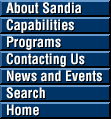|
Sandia to release enhanced shock wave physics software
Provides greater detail for simulating a projectile penetration
|

CTH IMAGES — This series of CTH images show the impact and penetration of a steel plate by a copper ball. The copper ball is eight millimeters in diameter impacting a plate of 4340 steel, four millimeters thick, at an impact velocity of 4.52 kilometers per second (10,111 miles per hour).
Download 300dpi JPEG image, ‘Picture_1.jpg’, 156K (Media are welcome to download/publish this image with related news stories.)
|
ALBUQUERQUE, N.M. — The latest version of the widely used shock wave physics computer code, CTH, developed by Sandia National Laboratories, will soon be available to customers nationwide. The code simulates high-speed impact and penetration phenomena involving a variety of materials.
Interest in the new version of the software is particularly high among customers like the Department of Energy (DOE) and Department of Defense (DoD), which use the software for studying weapon effects, armor/anti-armor interactions, warhead design, high-explosive initiation physics, and weapon safety issues. Major users include the national laboratories, the Army, Navy, and Air Force laboratories, and their subcontractors. At Sandia, a DOE laboratory, the code is used in national missile defense, hazardous material dispersal by explosive detonation, weapon components design, and reactive materials research.
For armor/anti-armor design — of interest to DoD — the software allows users to determine which types of bullets or projectiles can best penetrate armor. It also provides information about how to design an improved penetration protection mechanism.
“This new version is really exciting because it offers a computational capability never before available in this type of code, an adaptive mesh refinement model [AMR],” says Paul Taylor, head of the CTH project at Sandia. “AMR gives the software the ability to increase resolution and accuracy in those regions of a simulation where it is needed and reduce resolution in those regions where it is not. For example, in the simulation of a projectile penetrating a target material, greater resolution can be achieved in the region surrounding the impact interface between the two materials where large distortions and high strain rates are occurring.”
The medical community is also paying attention to Sandia’s CTH software. Taylor currently has a small collaborative research effort underway with the University of New Mexico School of Medicine, which is interested in using the shock physics code to better understand brain injury caused by physical trauma, such as a person’s head hitting a car windshield. Using the magnetic resonance image (MRI) of an individual’s head to construct a CTH model, simulations can be performed showing how shock waves travel through the head and cause brain damage.
The software breaks down the penetration simulation into millions of grid-like “cells.” As the modeled projectile (such as a copper ball impacting a steel plate) impacts and penetrates the target, progressively smaller blocks of cells are placed around the projectile, each showing in detail the deformation and breakup of the ball and target plate.
CTH with the AMR enhancement also offers the ability to analyze problems involving sophisticated materials with greater accuracy. With the addition of new material models, it can simulate a wider variety of materials, including metals, ceramics, plastics, composites, high explosives, rocket propellants, and gases.
Sandia developed the early precursor to CTH in the 1970s for one-dimensional problems, expanding it to simulate problems in two and three dimensions in the 1980s.
The Labs began licensing the shockwave physics code in the early 1990s to DOE, DoD, their contractors, and some private US companies with interests in shock physics.
An updated version of the software, which is export controlled, is distributed to customers about every 18 months. Currently 259 licenses have been issued.
DoD, DOE, and their contractors receive use licenses for a small distribution fee. Commercial companies can purchase licenses for $25,000. The updated software will be distributed on CDs at a cost of $400 for each noncommercial, licensed customer.
One of the most appealing aspects of CTH for users is that it can run on almost any computer platform. Taylor offers CTH classes at Sandia several times a year to users from all over the country.
Sandia is a multiprogram laboratory operated by Sandia Corporation, a Lockheed Martin Company, for the United States Department of Energy under contract DE-AC04-94AL85000. With main facilities in Albuquerque, N.M., and Livermore, Calif., Sandia has major research and development responsibilities in national security, energy and environmental technologies, and economic competitiveness.
Media contact:
Chris Burroughs, coburro@sandia.gov, (505) 844-0948
Technical contact:
Paul Taylor, pataylo@sandia.gov (505) 844-1960
|
